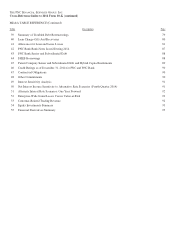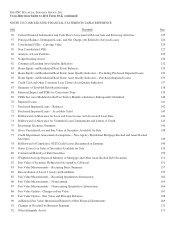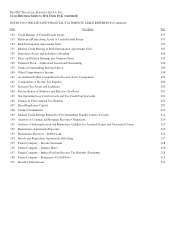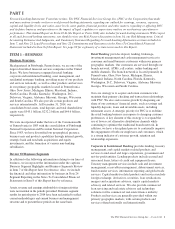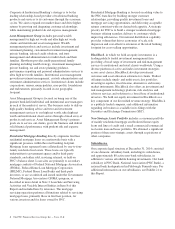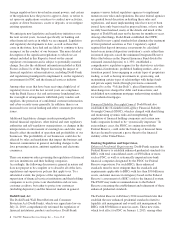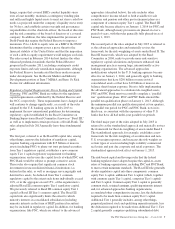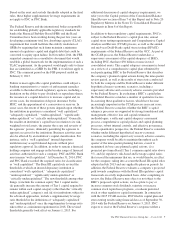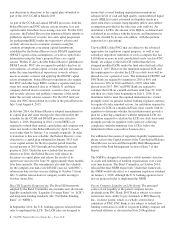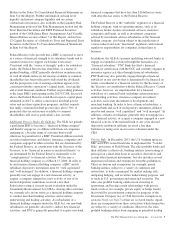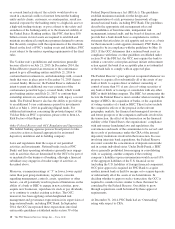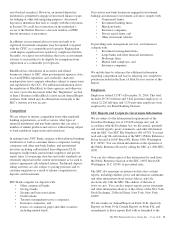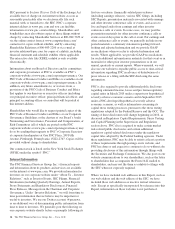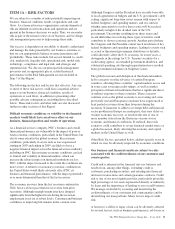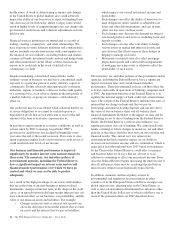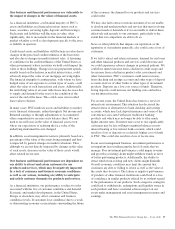PNC Bank 2014 Annual Report Download - page 25
Download and view the complete annual report
Please find page 25 of the 2014 PNC Bank annual report below. You can navigate through the pages in the report by either clicking on the pages listed below, or by using the keyword search tool below to find specific information within the annual report.Based on the asset and custody thresholds adopted in the final
rules, these higher supplementary leverage requirements do
not apply to PNC or PNC Bank.
The Federal Reserve and the international bodies responsible
for establishing globally applicable regulatory standards for
banks (the Financial Stability Board (FSB) and the Basel
Committee) have been working during the past few years on
developing a minimum total loss absorbing capacity (TLAC)
requirement that would facilitate the orderly resolution of
GSIBs by requiring that such firms maintain a minimum
amount of regulatory capital and eligible debt that could be
converted to equity upon failure. In November 2014, the FSB
requested comment on a consultative document that would
establish a global framework for the implementation of such a
TLAC requirement. As the proposal would apply only to firms
that are identified as a GSIB by the FSB, it would not apply to
PNC. The comment period on the FSB proposal ended on
February 2, 2015.
Failure to meet applicable capital guidelines could subject a
banking organization to a variety of enforcement remedies
available to the federal bank regulatory agencies, including a
limitation on the ability to pay dividends or repurchase shares,
the issuance of a capital directive to increase capital and, in
severe cases, the termination of deposit insurance by the
FDIC, and the appointment of a conservator or receiver. In
some cases, the extent of these powers depends upon whether
the institution in question is considered “well capitalized,”
“adequately capitalized,” “undercapitalized,” “significantly
undercapitalized” or “critically undercapitalized.” Generally,
the smaller an institution’s capital base in relation to its risk-
weighted or total assets, the greater the scope and severity of
the agencies’ powers, ultimately permitting the agencies to
appoint a receiver for the institution. Business activities may
also be affected by an institution’s capital classification. For
instance, only a “well capitalized” insured depository
institution may accept brokered deposits without prior
regulatory approval. In addition, in order to remain a financial
holding company and engage in the broader range of financial
activities authorized for such a company, PNC and PNC Bank
must remain “well capitalized.” At December 31, 2014, PNC
and PNC Bank exceeded the required ratios for classification
as “well capitalized.” The Basel III capital rule revised the
thresholds at which an insured depositary institution is
considered “well capitalized,” “adequately capitalized,”
“undercapitalized,” “significantly undercapitalized” or
“critically undercapitalized.” The new thresholds among other
things (i) include the common equity Tier 1 capital metric;
(ii) generally increase the amount of Tier 1 capital required to
remain within each capital category (other than the “critically
undercapitalized” category); and (iii) for institutions subject to
the advanced approaches, include a supplementary leverage
ratio threshold in the definitions of “adequately capitalized”
and “undercapitalized” once the supplementary leverage ratio
takes effect as a minimum requirement in 2018. The revised
thresholds generally took effect on January 1, 2015. For
additional discussion of capital adequacy requirements, we
refer you to the Capital portion of the Consolidated Balance
Sheet Review section of Item 7 of this Report and to Note 20
Regulatory Matters in the Notes To Consolidated Financial
Statements in Item 8 of this Report.
In addition to these regulatory capital requirements, PNC is
subject to the Federal Reserve’s capital plan rule, annual
capital stress testing requirements and Comprehensive Capital
Analysis and Review (CCAR) process, as well as the annual
and mid-year Dodd-Frank capital stress testing (DFAST)
requirements of the Federal Reserve and the OCC. As part of
the CCAR process, the Federal Reserve undertakes a
supervisory assessment of the capital adequacy of BHCs,
including PNC, that have $50 billion or more in total
consolidated assets. This capital adequacy assessment is based
on a review of a comprehensive capital plan submitted by
each participating BHC to the Federal Reserve that describes
the company’s planned capital actions during the nine quarter
review period, as well as the results of stress tests conducted
by both the company and the Federal Reserve under different
hypothetical macro-economic scenarios, including a
supervisory adverse and a severely adverse scenario provided
by the Federal Reserve. In evaluating a BHC’s capital plan,
the Federal Reserve considers a number of qualitative factors.
In assessing these qualitative factors, which have become
increasingly important in the CCAR process in recent years,
the Federal Reserve considers whether the BHC’s capital
adequacy processes are supported by strong foundational risk
management, effective loss and capital estimation
methodologies, a sufficient capital adequacy assessment
process, comprehensive capital policies and capital planning
processes, robust internal controls, and effective governance.
From a quantitative perspective, the Federal Reserve considers
whether under different hypothetical macro-economic
scenarios, including the supervisory severely adverse scenario,
the company would be able to maintain throughout each
quarter of the nine quarter planning horizon, even if it
maintained its base case planned capital actions, (i) a
projected pro forma Basel I Tier 1 common capital ratio above
5%, and (ii) regulatory risk-based and leverage capital ratios
that exceed the minimums that are, or would then be, in effect
for the company, taking into account the Basel III capital rules
adopted in July 2013 and any applicable phase-in periods. In
addition, the Federal Reserve evaluates a company’s projected
path towards compliance with the Basel III regulatory capital
framework on a fully implemented basis. After completing its
review, the Federal Reserve may object or not object to the
BHC’s proposed capital actions, such as plans to pay or
increase common stock dividends, reinstate or increase
common stock repurchase programs, or redeem preferred
stock or other regulatory capital instruments. In connection
with the 2015 CCAR exercise, PNC filed its capital plan and
stress testing results using financial data as of September 30,
2014 with the Federal Reserve on January 5, 2015. PNC
expects to receive the Federal Reserve’s response (either a
The PNC Financial Services Group, Inc. – Form 10-K 7


